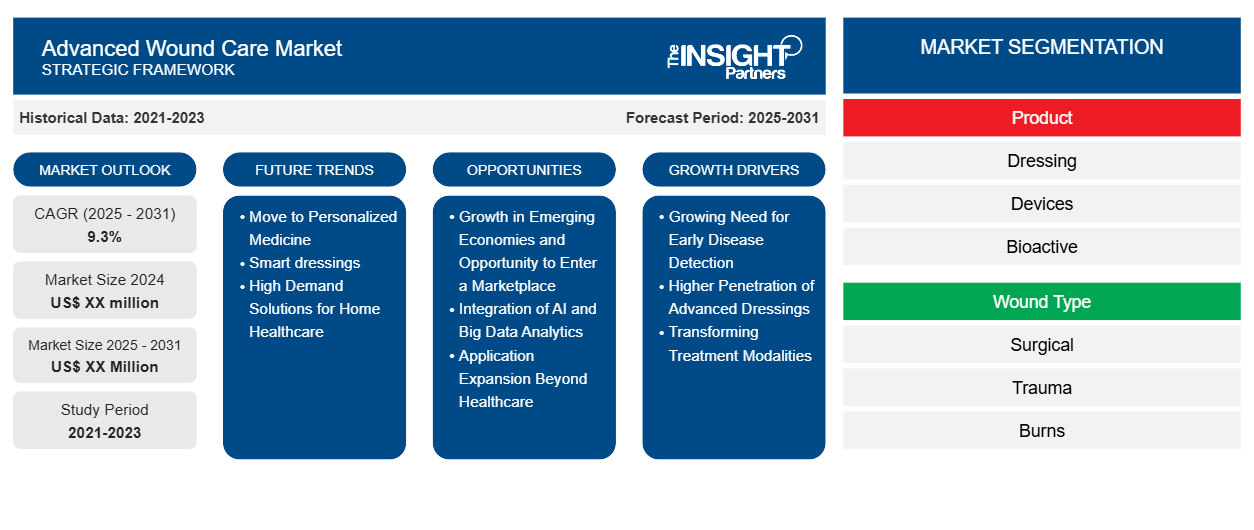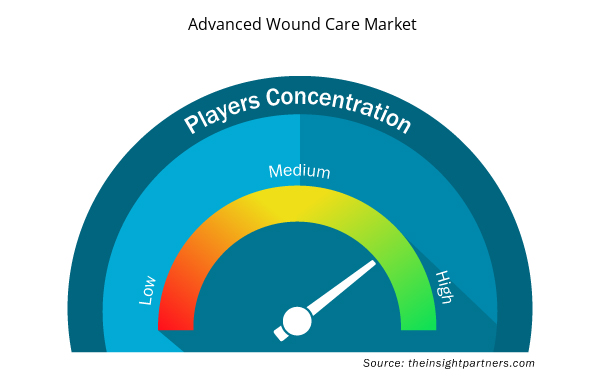The Advanced Wound Care Market is expected to register a CAGR of 9.3% from 2025 to 2031, with a market size expanding from US$ XX million in 2024 to US$ XX Million by 2031.
This report on Advanced Wound Care Market presents an analysis of the market scenario with regards to the present and future outlook besides key sector drivers. The Advanced Wound Care Market is segmented into further categories based on subsegments and by product type, Wound type, and end user.
The global analysis is further extended into the regional level, which includes its key markets such as North America, Europe, Asia-Pacific, Latin America, and Middle East & Africa. By fragmenting the analysis at this level, the stakeholders can track the local trends, regulatory environment, and growth opportunities prevailing in a particular region under consideration. The above market evaluation is represented in US dollars (US$) reflecting the growth patterns, market sizes, and revenue forecasting corresponding to the above analysis.
Purpose of the Report
The report Advanced Wound Care Market by The Insight Partners aims to describe the present landscape and future growth, top driving factors, challenges, and opportunities. This will provide insights to various business stakeholders, such as:
- Technology Providers/Manufacturers: To understand the evolving market dynamics and know the potential growth opportunities, enabling them to make informed strategic decisions.
- Investors: To conduct a comprehensive trend analysis regarding the market growth rate, market financial projections, and opportunities that exist across the value chain.
- Regulatory bodies: To regulate policies and police activities in the market with the aim of minimizing abuse, preserving investor trust and confidence, and upholding the integrity and stability of the market.
Advanced Wound Care Market Segmentation
Product
- Dressing
- Devices
- Bioactive
Wound Type
- Surgical
- Trauma
- Burns
- Ulcers
- Diabetic food
- Others
End User
- Hospitals
- Ambulatory
- Wound care centers
- others
Geography
- North America
- Europe
- Asia-Pacific
- South and Central America
- Middle East and Africa
Customize This Report To Suit Your Requirement
You will get customization on any report - free of charge - including parts of this report, or country-level analysis, Excel Data pack, as well as avail great offers and discounts for start-ups & universities
Advanced Wound Care Market: Strategic Insights

- Get Top Key Market Trends of this report.This FREE sample will include data analysis, ranging from market trends to estimates and forecasts.
Advanced Wound Care Market Growth Drivers
- Growing Need for Early Disease Detection:
Early detection of infectious diseases is critical to effective treatment, leading to higher adoption of rapid testing methods across healthcare facilities.
- Higher Penetration of Advanced Dressings: Innovated treatment possibilities include technologies like bioengineered skin substitutes, negative pressure wound therapy, and hydrocolloid dressings that have taken wound care to the next level. Advanced dressing-related studies confirm that healing times are shortened by up to 50% compared to other methods; thus, treatment outcomes are improved. In a nutshell, the advanced wound care market is driven by increasing incidences of chronic wounds, an aging population, advancements in technology, increased healthcare expenditure, shifting towards home healthcare, increased awareness, and favorable regulations; hence, it promises a very strong growth potential. Some of the other major trends include enhanced use of advanced dressings including hydrocolloid, foam, and alginate dressings. The manufacture of these products is aimed at providing an ideal moist wound environment to facilitate fast healing of wounds. Advanced dressings are reported to cut the time of healing by as high as 50% compared to traditional gauze in literature. For this reason, these dressings are increasingly gaining momentum among healthcare providers.
- Transforming Treatment Modalities: While innovative technologies in wound care transform the treatment modalities, smart dressings with implanted sensors that can provide real-time monitoring of the wound condition have become common. This was proved in a study published in the Journal of Wound Care when such smart dressings helped reduce infection rates and improve healing by timely provision of data to the healthcare providers. Moreover, bioengineered skin substitutes find their place in clinical trials and thus are fast gaining favor.
Advanced Wound Care Market Future Trends
- Move to Personalized Medicine: Personalized medicine is finding its way into wound management, where therapies are provided for specific needs. There is an increasing trend towards bespoke solutions for the care of wounds that are devised with regard to unique characteristics in a patient, such as genetic profiles and traits of a wound. This trend is supported based on accumulation of evidence to date that personalized approaches can considerably improve outcomes in healing.
- Smart dressings: Smart dressings have integrated sensors that display in real-time the true condition of the wound to improve management and outcomes. Other areas of high growth include the integration of AI and machine learning for data analysis and predictive analytics.
- High Demand Solutions for Home Healthcare: That means, the greater the momentum of home healthcare, the greater will be the demand for sophisticated wound care products that are easy to operate and usable in non-clinical environments. Therefore, companies designing portable, user-friendly solutions for wound care can cash in on this trend.
Advanced Wound Care Market Opportunities
- Growth in Emerging Economies and Opportunity to Enter a Marketplace: It would not be wrong to say that, with each day passing by, the infrastructure of healthcare and its expenditures are on their way to growing in the emergent economies.
- Integration of AI and Big Data Analytics:
The incorporation of artificial intelligence (AI) and data analytics in microbiology testing systems enables faster pathogen identification, predictive analysis, and better disease management, presenting a lucrative market opportunity. - Application Expansion Beyond Healthcare: Increasing use of microbiology testing in industries such as food and beverage, agriculture, and environmental monitoring broadens the market's scope and revenue streams. Now, as more people are becoming knowledgeable about advanced wound care products, companies have ample opportunities for market entry into new areas, offering new products and solutions in these geographic regions.
Advanced Wound Care Market Regional Insights
The regional trends and factors influencing the Advanced Wound Care Market throughout the forecast period have been thoroughly explained by the analysts at Insight Partners. This section also discusses Advanced Wound Care Market segments and geography across North America, Europe, Asia Pacific, Middle East and Africa, and South and Central America.

- Get the Regional Specific Data for Advanced Wound Care Market
Advanced Wound Care Market Report Scope
| Report Attribute | Details |
|---|---|
| Market size in 2024 | US$ XX million |
| Market Size by 2031 | US$ XX Million |
| Global CAGR (2025 - 2031) | 9.3% |
| Historical Data | 2021-2023 |
| Forecast period | 2025-2031 |
| Segments Covered |
By Product
|
| Regions and Countries Covered | North America
|
| Market leaders and key company profiles |
Advanced Wound Care Market Players Density: Understanding Its Impact on Business Dynamics
The Advanced Wound Care Market market is growing rapidly, driven by increasing end-user demand due to factors such as evolving consumer preferences, technological advancements, and greater awareness of the product's benefits. As demand rises, businesses are expanding their offerings, innovating to meet consumer needs, and capitalizing on emerging trends, which further fuels market growth.
Market players density refers to the distribution of firms or companies operating within a particular market or industry. It indicates how many competitors (market players) are present in a given market space relative to its size or total market value.
Major Companies operating in the Advanced Wound Care Market are:
- Smith & Nephew
- Acelity L.P.
- Braun Melsungen AG
- Integra Lifesciences Corporation
- ConvaTec
Disclaimer: The companies listed above are not ranked in any particular order.

- Get the Advanced Wound Care Market top key players overview
Key Selling Points
- Comprehensive Coverage: The report comprehensively covers the analysis of products, services, types, and end users of the Advanced Wound Care Market, providing a holistic landscape.
- Expert Analysis: The report is compiled based on the in-depth understanding of industry experts and analysts.
- Up-to-date Information: The report assures business relevance due to its coverage of recent information and data trends.
- Customization Options: This report can be customized to cater to specific client requirements and suit the business strategies aptly.
The research report on the Advanced Wound Care Market can, therefore, help spearhead the trail of decoding and understanding the industry scenario and growth prospects. Although there can be a few valid concerns, the overall benefits of this report tend to outweigh the disadvantages.
- Historical Analysis (2 Years), Base Year, Forecast (7 Years) with CAGR
- PEST and SWOT Analysis
- Market Size Value / Volume - Global, Regional, Country
- Industry and Competitive Landscape
- Excel Dataset



Report Coverage
Revenue forecast, Company Analysis, Industry landscape, Growth factors, and Trends

Segment Covered
Product, Wound Type, and End User

Regional Scope
North America, Europe, Asia Pacific, Middle East & Africa, South & Central America

Country Scope
This text is related
to country scope.
Frequently Asked Questions
Some of the customization options available based on request are additional 3-5 company profiles and country-specific analysis of 3-5 countries of your choice. Customizations are to be requested/discussed before making final order confirmation, as our team would review the same and check the feasibility.
Key players in advanced wound care market are - Smith Nephew, Acelity L P, Braun Melsungen AG, Integra Lifesciences Corporation, ConvaTec, 3M, MiMedx Inc, Mölnlycke Health Care, Paul Hartmann AG
The report can be delivered in PDF/PPT format; we can also share excel dataset based on the request.
The market is expected to register a CAGR of 9.3% during 2023-2033
The advanced wound care industry is driven by various factors such as the increased prevalence of chronic wounds, aging populations, technological advancements, rising healthcare costs, shift toward home healthcare, increased awareness, and regulatory frameworks that support innovation and product development.
Trends in the advanced wound care market include increased adoption of smart dressings, advancements in bioengineered solutions, a focus on personalized medicine, growth in telehealth services, and enhanced regulatory support, all aimed at improving patient outcomes and treatment efficiency.
Trends and growth analysis reports related to Life Sciences : READ MORE..
The List of Companies - Advanced Wound Care Market
- Smith & Nephew
- Acelity L.P.
- Braun Melsungen AG
- Integra Lifesciences Corporation
- ConvaTec
- 3M
- MiMedx, Inc.
- Mölnlycke Health Care
- Paul Hartmann AG
- Cardinal Health, Inc.

 Get Free Sample For
Get Free Sample For